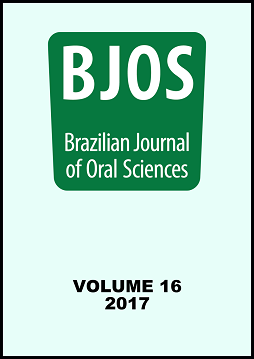Abstract
Aim: To determine the current trends in technological armamentarium and endodontic treatment among Brazilian endodontists. Methods: A total of 279 endodontists answered a web-based survey questionnaire about their region of activity in Brazil and years as a specialist, average number of endodontic cases treated per month, number of visits to complete the treatment, use of rubber dam for isolation, type of irrigant, obturation technique and device used for this purpose, temporary filling materials, and greater difficulty encountered during treatment and technological armamentarium. A descriptive analysis, expressed in terms of frequency and percentage, was performed and the data were correlated using the chi-square test (p0.05). Results: Most of the respondents had up to 10 years as specialists. More than 50% of endodontists preferred to complete the endodontic treatment in a single visit. Ninety-nine percent of endodontists used rubber dam for isolation. NaOCl was the most widely used irrigant. Most of the respondents associated different techniques for root canal filling. Lateral condensation and Continuous wave of condensation were the isolated technique most reported. Filling devices (thermocompactors) were used by 53% of endodontists. Glass ionomer was the preferred temporary filling material. The answers for the use of technological armamentarium revealing that 94% of endodontists used an apex locator; 67.38% utilized magnification (loupe: 23.66%; microscope: 35.48%; microscope and loupe: 8.24%); 58% reported to digital radiography; and 47.31% used computed tomography as a complementary tool. About mechanized instrumentation, 44.44% endodontists employed rotary and reciprocating files. The difficulties encountered during endodontic treatment were classified as preparation > access > obturation > anesthesia > isolation. Conclusions: Most endodontists have implemented new technologies, such as mechanical instrumentation, apex locators, magnification, digital radiography, computed tomography, ultrasound, and obturation tools, in their clinical practice.References
Zou H, Li Y, Lian X, Yan Y, Dai X, Wang G. Frequency and In uencing Factors of Rubber Dam Usage in Tianjin: A Questionnaire Survey. Int J Dent. 2016;2016:7383212. doi: 10.1155/2016/7383212.
Lababidi EA. Discuss the impact technological advances in equipment and materials have made on the delivery and outcome of endodontic treatment. Aust Endod J. 2013 Dec;39(3):92-7.
doi: 10.1111/aej.12040.
Mortman RE. Technologic advances in endodontics. Dent Clin North Am. 2011 Jul;55(3):461-80 , vii-viii. doi: 10.1016/j.cden.2011.02.006.
Lee M, Winkler J, Hartwell G, Stewart J, Caine R. Current trends in endodontic practice: emergency treatments and technological armamentarium. J Endod. 2009 Jan;35(1):35-9. doi: 10.1016/j.joen.2008.10.007.
Glickman GN, Koch KA. 21st-century endodontics. J Am Dent Assoc. 2000 Jun;131 Suppl:39S-46S.
Bahcall J. Today’s endodontic therapy driven by advances in technology, changes in thinking. Com- pend Contin Educ Dent. 2015 May;36(5):378-9.
Bjørndal L, Reit C. The adoption of new endodontic technology amongst Danish general dental practi- tioners. Int Dent J. 2005 Jan;38(1):52-8.
Clarkson RM, Podlich HM, Savage NW, Moule AJ. A survey of sodium hypochlorite use by general dental practitioners and endodontists in Australia. Aust Dent J. 2003 Mar;48(1):20-6.
Dutner J, Mines P, Anderson A. Irrigation trends among American Association of endodontists mem- bers: A web-based survey. J Endod. 2012 Jan;38(1):37-40. doi: 10.1016/j.joen.2011.08.013.
Gupta R, Rai R. The adoption of new endodontic technology by Indian dental practitioners: A questio- nnaire survey. J Clin Diagn Res. 2013 nov; 7(11):2610-4. doi: 10.7860/JCDR/2013/5817.3628.
Hommez GMG, Braem M, de Moor RJG. Root canal treatment performed by Flemish dentists. Part 1. Cleaning and shaping. Int Dent J. 2003 Mar;36(3):166-73.
Iqbal A, Akbar I, Qureshi B, Sghaireen MG, AL-Omiri MK. A survey of standard protocols for endodon- tic treatment in north of KSA. ISRN Dent. 2014 May 4;2014:865780. doi: 10.1155/2014/865780.
Kaptan RF, Haznedaroglu F, Kayahan MB, Basturk FB. An investigation of current endodontic practice in Turkey. Scienti cWorldJournal. 2012;2012:565413. doi: 10.1100/2012/565413.
Kersten DD, Mines P, Sweet M. Use of the microscope in endodontics: Results of a questionnaire. J Endod. 2008 Jul;34(7) 804-7. doi: 10.1016/j.joen.2008.04.002.
Locke M, Thomas MB, Dummer PMH. A survey of adoption of endodontic nickel-titanium rotary instrumentation part 1: general dental practitioners in Wales. Br Dent J. 2013 Feb;214(3):E6. doi: 10.1038/sj.bdj.2013.108.
Lynch CD, McConnell RJ. Attitudes and use of rubber dam by Irish general dental practitioners. Int Endod J. 2007 Jun;40(6):427-32.
Savani GM, Sabbah W, Sedgley CM, Whitten B. Current trends in endodontic treatment by general dental practitioners: Report of a United States national survey. J Endod. 2014 May;40(5):618-24. doi: 10.1016/j.joen.2014.01.029.
Slaus G, Bottenberg P. A survey of endodontic practice amongst Flemish dentists. Int Endod J. 2002 Sep;35(9):759-67.
Gurgel Filho ED, Coutinho Filho T, de Deus G, Krebs RL. [Critical study of the philosophy of endodon- tic treatment in a single session in Brazilian and North American universities]. Rev Bras Odontol. 1999;56(4):148-52. Portuguese.
Santos KS, Oliveira MRNS, Moraes VR. [Conception of endodontists regarding new technologies and teaching in the area]. Rev Bras Odontol. 2001;58(6):368-72. Portuguese.
Pedrosa FAS, Silveira RR, Yamauti M, Castro CDL, Freitas ABDA. [Isolation of the Operative Field: panorama of use in private clinics and clinics of Belo Horizonte. MG, Brazil]. Pesq Bras Odontoped Clin Integr. 2011;11(3):443-9. Portuguese.
Udoye CI, Sede MA, Jafarzadeh H, Abbott PV. A survey of endodontic practices among dentists in Nigeria. J Contemp Dent Pract. 2013 Mar;14(2):293-8.
Whitten BH, Gardiner DL, Jeansonne BG, Lemon RR. Current trends in endodontic treatment: report of a national survey. J Am Dent Assoc. 1996 Sep;127(9):1333-41.
Gutmann JL. Revisting the scope of contemporary endodontics. Dent Today. 2015 May;34(5):14-5.
Kishen A, Peters OA, Zehnder M, Diogenes AR, Nair MK. Advances in endodontics: Poten- tial applications in clinical practice. J Conserv Dent. 2016 May-Jun;19(3):199-206.
doi: 10.4103/0972-0707.181925.
The Brazilian Journal of Oral Sciences uses the Creative Commons license (CC), thus preserving the integrity of the articles in an open access environment.

